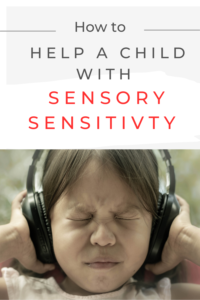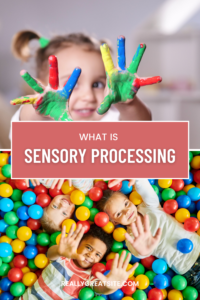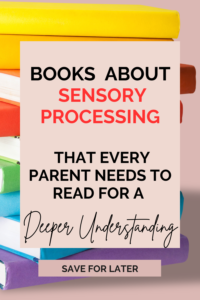
Unleash Your Child’s Potential: Expert Tips for Navigating Sensory Sensitivity
Do you ever feel like the world is just too much for your child? Having a child with sensory sensitivity or sensory processing disorder can be difficult at times.
Empower yourself by learning more about sensory sensitivity and strategies to make life a little easier for your child. This post was created by Marra Robert, OTD, OTRL

Do you ever feel like the world is just too much for your child? The bright lights, the loud noises, the overwhelming sensations? Is it challenging to go to new environments, busy stores, or family and friends’ parties and events?
Are these experiences too overwhelming for your child? Do you wish your child could enjoy these activities a little more and worry a little less?
If so, you’re not alone. Many children experience sensory sensitivity, making it difficult for them to navigate daily life.
It’s important to understand that is challenging. However, it does not define your child and is no fault to your child or you as the parent.
Hi! My name is Marra, and I am a mama of a sweet little girl and a pediatric occupational therapist. I’ve spent years working with children of all ages with different developmental needs and supporting their parents and families as they navigate the ups and downs of child development.
The majority of the children I worked with have some sort of sensory processing needs or challenges, and I loved collaborating with parents to develop individualized strategies to help improve their sensory processing skills, achieve goals. and do big things!
In this article, I’d love to provide you with a deeper understanding of sensory processing, sensory sensitivities, and strategies to help.
That being said, this post does not replace the high value of consulting with or working with a pediatric occupational therapist since every child has different needs and requires an individualized treatment plan.
In this article, we’ll delve into understanding sensory sensitivity, identifying signs and triggers, creating a sensory-friendly environment, developing coping strategies and skills, collaborating with professionals and educators, and ultimately unleashing your child’s hidden potential.
By implementing the tips provided, you can create a supportive environment for your child to grow and thrive. So, let’s dive in and unlock the incredible abilities within your child! Before we get started, we first need to understand both sensory processing and sensory sensitivity.
what is sensory processing?
Sensory processing is our ability to take in information from our environment through our 8 sensory systems, filter and try to understand the information, and then choose an appropriate response to that information.
Yes, we have 8 sensory systems. We have more familiar 5 sensory systems including sight, sound, touch, smell, and taste. We also have 3 less well-known sensory systems: vestibular, proprioceptive, and interoception.
Our vestibular sense is our sense of movement and our response to gravity. We need this sense in order to maintain balance while we move around our environment.
Proprioception is our sense of deep pressure and body awareness. Interoception is the sense of how our body is feeling. If you would like to learn more about our 8 sensory systems, check out What is Sensory Processing..

Understanding Sensory Sensitivity in chliren
To truly support your child and help them navigate their sensory sensitivity, it’s important to first understand what exactly sensory sensitivity is.
Sensory sensitivity, which can go along with sensory processing disorder, is a condition where the brain has trouble receiving and responding to certain information that comes through the senses. This means that everyday sights, sounds, smells, tastes, and textures can be overwhelming and difficult for your child to process.
Children with sensory sensitivity often experience the world in a different way than their peers. While most of us can filter out background noise or tolerate certain textures, children with sensory sensitivity may struggle with even the most ordinary things.
Bright lights, loud noises, crowded spaces, certain fabrics, and even certain smells can trigger a sensory overload for them.
Here’s an example of how our brain filters out unnecessary sensory information. Let’s say right now you are reading this blog post, and your children are playing in the next room.
You can hear them talking, playing, and giggling if you listen. However, you are able to tune them out and attend to this post you are reading.
Now let’s say something happens, and you hear one of your children scream or start to cry. You will immediately stop reading and attend to your children to investigate what is going on.
The important thing to note here is that you will very quickly switch your attention from this post to your child automatically without thinking about it. It happens unconsciously, and it’s not a choice.
This is so important to understand because sensory processing happens automatically and is unconscious or out of our conscious awareness. It is the same for your children. Their sensory sensitivity is out of their conscious control.
Now, let’s say that you are reading this article, and you are unable to tune out any background noise at all. It would probably be really difficult to attend to the article, and you probably would get frustrated and overwhelmed.
Sensory sensitivity is not a choice or something that your child can simply “get over.” It is a legitimate neurological condition that affects how the brain processes and responds to sensory information.
Understanding this is crucial in order to create a supportive and understanding environment for your child.
By understanding your child’s sensory sensitivity and the impact it has on their everyday life, you can become their biggest advocate.
Educate yourself about sensory processing disorder, seek guidance from occupational therapists, and collaborate with your child’s teachers and caregivers to create a supportive network that understands and accommodates their unique needs.

understanding the signs and triggers of sensory sensitivity
To effectively navigate your child’s sensory sensitivity, it is crucial to be able to recognize the signs and triggers that can cause discomfort or overwhelming reactions.
Every child is unique, and their sensory experiences can vary greatly from one another. By paying close attention to their behaviors and responses, you can gain valuable insights into what triggers their sensory sensitivities.
One key aspect of identifying signs is observing how your child reacts to certain stimuli. Keep a watchful eye for any unusual or intense reactions to sensory input such as touch, sound, taste, smell, or visual stimuli.
Does your child become agitated or cover their ears when exposed to loud noises? Do they avoid certain textures or show aversion towards specific smells or tastes?
These could be indicators of sensory sensitivities that require further attention and understanding.
It is also important to pay attention to your child’s nonverbal cues. Often, children may not be able to express their discomfort or sensory overload through words.
Instead, they might resort to behaviors like fidgeting, avoiding eye contact, or withdrawing from social interactions. Some children respond more loudly, while others shut down and shy away.
By recognizing these nonverbal signals, you can better support your child and address their sensory needs.
Understanding and identifying the signs and triggers of your child’s sensory sensitivity is the first step in providing the necessary support and accommodations they need.
By doing so, you can better prepare yourself to create a sensory-friendly environment that caters to their unique needs, as we will explore in the next section.

establishing trust and respecting the sensory sensitivity
Trust is not something that we often think about with our children because, typically, it is innate to our children and always present in a healthy parent-child relationship.
However, with children with sensory sensitivity, it is so important to maintain a high level of trust with that child and to respect their sensory sensitivity.
As mentioned previously, sensory sensitivity or sensory processing disorder is not a choice or behavior. It is out of the child’s conscious control and oftentimes leads to fear and anxiety.
Whatever the sensory input is, it doesn’t feel good to them, so it can develop; into anxiety.
It’s common to think that if we are able to sneak in the unwanted item or just expose the child to whatever they are sensitive to, this can decrease their sensitivity to the item by desensitization.
This is common with unwanted food. Maybe if I force them to try a nonpreferred food or hide it in a preferred food, then they will try it and like it.
These tactics actually can have the opposite effect than intended and increase the child’s sensitivity. On top of that, it can break the trust between you and the child and may lead to the child not trusting what you feed them.
I’ve seen situations where a nonpreferred food is hidden in the preferred food, and then the child ends up no longer eating the preferred food that they once enjoyed because they have lost the trust.
To help with their sensory sensitivity, you can teach the child that they are in control of their own body, and if they say “no” or “I need a break,” their voices and needs will be respected.
The way to help with sensory sensitivity is to collaborate with a professional and develop a plan to slowly introduce the input or activity while maintaining trust and respecting the child.
As an occupational therapist, whenever I worked with a child with sensory sensitivity, I would spend the first few sessions just focusing on building trust and rapport before even thinking about targeting the sensory sensitivity.
I know that if my client doesn’t trust me, were not going to be able to accomplish much.
I would first focus on making our therapy sessions fun, letting the child know that I respected their voice (or body language for those who weren’t speaking), and making sure they knew that they were in a safe space when they were with me.
Yes, this might take a few weeks to establish; however, if I did focus on building rapport first, then we would be able to progress more quickly with their sensory sensitivity goals.
Once we have established a safe space, we can look closer at the environment.
creating a sensory friendly environment
Creating a sensory-friendly environment is essential in helping your child thrive and unleash their full potential. By making a few simple adjustments, you can greatly minimize sensory overload and ensure a more comfortable and enjoyable experience for your child.
One key aspect of creating a sensory-friendly environment is to consider the lighting. Bright lights can be overwhelming for children with sensory sensitivities, so opting for softer, dimmer lighting can make a significant difference.
Try to avoid fluorescent lights whenever possible. Natural light is always going to be less overwhelming, so use it whenever possible.
Another important factor to consider is the noise level in your child’s environment. Loud or sudden noises can be distressing for children with sensory sensitivity.
Try to minimize background noise by turning off the television or radio when not in use and using curtains or carpets to absorb sound.
You can also introduce white noise machines or soothing music to help mask any sudden or distracting sounds. Always warn a child before staring a loud noise such as a vacuum or blender.
Additionally, paying attention to the textures and materials in your child’s surroundings can greatly impact their comfort. Some children may have aversions to certain fabrics or textures, so it’s worth experimenting with different materials to find what works best for them.
Soft, comfortable clothing and bedding can make a big difference in providing a more sensory-friendly experience.
Finally, creating clear and consistent routines can be incredibly beneficial for children with sensory sensitivities. This is because they will be more comfortable when they know what to expect.
Predictability helps them feel secure and reduces anxiety. Establishing a daily routine that includes regular mealtimes, playtimes, and rest periods can provide structure and stability in their day.

developing coping strategies and skills
In addition to creating a sensory-friendly environment to support your child’s needs, it is important to help them develop coping strategies and skills.
By equipping them with the tools to navigate sensory sensitivity, you can empower them to overcome challenges and lead a fulfilling life.
One effective way to support your child in developing coping strategies is to provide them with a range of activities that promote self-regulation and relaxation.
These activities can include deep breathing exercises, mindfulness techniques, or engaging in sensory play. Encourage your child to explore different strategies and find what works best for them.
Another important aspect of building coping skills is teaching your child how to identify and communicate their emotions. Oftentimes, children with sensory sensitivities may struggle to articulate what they are feeling, leading to frustration and anxiety.
By fostering open and honest communication, you can help your child express their emotions and find effective ways to cope with them.
Furthermore, it can be beneficial to introduce your child to social stories or visual cues that provide guidance on how to manage sensory overload or challenging situations. These tools can help your child understand what to expect and offer step-by-step instructions on how to cope.
As you guide your child in the development of coping strategies and skills, it is essential to remember that progress takes time and patience. Each child is unique, and what works for one may not work for another. Be adaptive and flexible in your approach and celebrate small victories along the way.
By fostering the development of coping strategies and skills, you are setting the stage for your child to thrive and reach their full potential. In the following section, we will delve into how collaborating with occupational therapists can further enhance your child’s journey toward sensory sensitivity awareness and growth.
OCCUPATIONAL THERAPY FOR CHILDREN WITH SENSORY SENSITIVITY
Collaborating with occupational therapists is a valuable resource in supporting your child’s sensory sensitivity development.
Occupational therapists bring specialized knowledge and experience that can help tailor strategies to your child’s specific needs.
One key advantage of collaborating with occupational therapists is their ability to conduct thorough assessments to understand your child’s sensory sensitivity better.
These assessments can help identify specific triggers, patterns, and behaviors that may be associated with sensory processing challenges. With this knowledge, occupational therapists can develop personalized strategies and interventions that target your child’s unique needs.
If you are interested in learning more about occupational therapy and a pediatric occupational therapy evaluation, check out the post linked below.
Occupational therapists can also offer valuable advice and suggestions on how to create a sensory-friendly environment both at home and in educational settings. They can help identify modifications or accommodations that can be made to optimize your child’s learning and reduce sensory overload.
Through their collaboration, occupational therapists can provide the necessary support and resources to ensure your child’s success and growth.

Remember, your child’s journey towards sensory sensitivity awareness and growth is a partnership that involves not just you but also professionals and educators.
Their expertise and guidance can have a profound impact on your child’s progress. By working together, you can create a supportive and nurturing environment that empowers your child to reach their full potential.
As you embark on this journey of empowering your child’s potential, remember that growth is not linear. There may be setbacks and challenges along the way, but with perseverance and patience, you can help your child flourish.
Stay open-minded and adaptable, adjusting your approach based on their evolving needs and progress.
